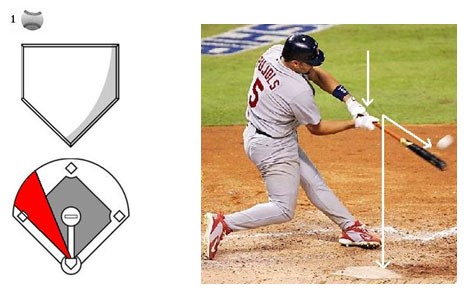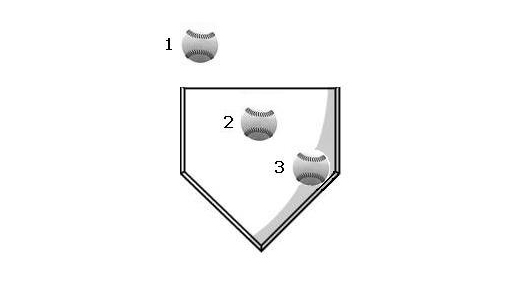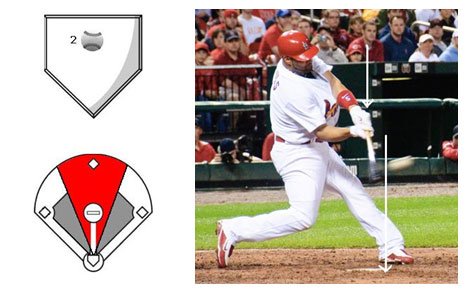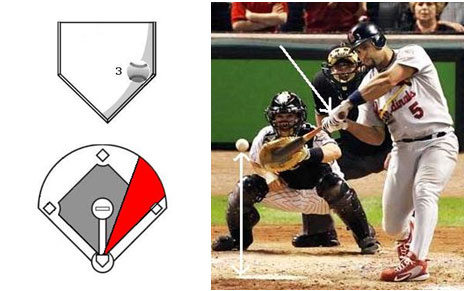Go With the Pitch – Every Pitch!

Every player at one time in their life has heard their coach tell them to “go with the pitch”. Unfortunately, the only time players usually hear that phrase is when it’s an outside pitch. What most players don’t understand (and some coaches) is that you should be doing that for every pitch. The batter must be taught to “go with the pitch” wherever the pitch is thrown.
This is a quick overview and will cover the three general pitch locations and when and where to hit the ball. This is the basic foundation you must learn before you can learn the advanced techniques. We will be using diagrams for right handed hitters: 1 – inside, 2 – middle and 3 – outside. Obviously reverse for lefties!

First things first – before I conduct the first hitting lesson and then every subsequent lesson afterwards, I always say this to the player: “You are going to the plate expecting to swing at every pitch.” Why? If you decide to swing after the pitch is thrown – you’re too late. The approach is you decide not to swing vs. to swing. As a batter, you must also know where you are hitting the ball when you swing. Identifying the pitch location and knowing where you are going to hit it allows you to get the most success out of every at bat.
#1 – The Inside Pitch
The inside pitch, if you’re going to swing at it, has to be hit out in front. The moment it’s over the plate you won’t get solid contact; if you even hit it. The reason why batters get “jammed” or “sawed off” is because they have allowed the inside pitch to travel too far to the plate. The batter cannot get the barrel of the bat to the ball and if hit, will get the handle. You’ve seen batters try to swing at an inside pitch too late and they can’t get the barrel of the bat to the ball. In fact, most batters actually stand up and bring their hands and arms into their body while trying to swing. I like to refer to it as Alligator Arms.
Here’s where you have to “go with the pitch”. You have to hit the ball out in front (see diagram 2). It’s not about stepping out to swing. An easy way to remember is, “It’s about getting to it before it gets to you….literally!” You’ll have to start your swing a bit earlier but it shouldn’t be a problem because you are ready to swing at every pitch.
You’re not hitting the ball way out in front, just about 8-12 inches in front of where you would normally swing at a pitch down the middle of the plate. I will say it’s a little misleading to say “out in front” because you do have to take into consideration where you are set up in the batters box. If you’re up in the box or in the middle of the box, you will be hitting the ball before it gets to the plate. If your deep in the box (toward the back), the ball will be at the very front of the plate when you hit it. Just remember the ball needs to be hit out in front of you.

Look at Albert Pujols in diagram 2. The ball is inside. His shoulders, hips down to his feet are square with the pitcher (NOT stepping out). His hands are slightly behind the ball because he’s hitting it in front of him. An inside pitch will be pulled which is illustrated by the red shaded area on the baseball diamond. Never try to go opposite field with the inside pitch – it’s impossible. This is a pitch that will be pulled every time.
Summary: Inside pitch, hit early and know you’re going to pull it.
#2 – Down the Middle
Here’s the pitch every batter loves to see and every pitcher tries to avoid throwing. This is the most comfortable pitch location for batters. Every batter has learned their swing from hitting the pitch down the middle. There’s not too much to be said about this pitch location because it doesn’t take much adjustment. It is also the most forgiving pitch location. If you’re a little early, you’ll pull the ball. If you’re a little late it will go opposite field. But the true location to hit the pitch down the middle is in the power alleys from left center to right center. (See diagram 3). To do that you must let the ball travel over the plate, but remember to take into consideration your position in the batters box. For batter set up at the front or the middle, the ball will make it to the front of the plate or a few inches in. For the batters in the back, the ball will travel to about the middle of the plate.

Summary: Look at Albert Pujols in diagram 3. The ball is down the middle. The front long arrow is the front of the plate. His shoulders, hips down to his feet are again square with the pitcher. His hands are right in line with the ball at contact and the ball has just crossed the plate (The ball is leaving the bat in this picture). The pitch down the middle is the most forgiving pitch to hit but you should let the ball travel over the plate from the front edge to the middle of the plate, depending upon your set up in the batters box and hit into the power alleys (red shaded area).
#3 – The Outside Pitch
This is the one pitch most batters hate to see and many try to pull; big mistake. You don’t have to pull a ball to hit with power. The trick to correctly hitting an outside pitch and with power is to let it travel deep over the plate and know you aren’t going to pull it but go opposite field (See red shaded area on baseball diamond in diagram 4). To make it simple, use the same approach as if you are going to hit an off speed pitch – you have to stay back. Here’s how to tell when the batter isn’t letting the outside pitch travel a little further over the plate. The most frequent tell tail sign is when they cast their hands out, bend at the hips and stick their butt out backwards towards the dugout and they aren’t square with the pitcher. I know you’ve seen it.

Summary: Now look at Albert Pujols in Diagram 4. The ball is obviously on the outside corner. Again, his shoulders, hips down to his feet are square with the pitcher. The arrow to his hands shows that they are slightly ahead of the ball because he’s letting the ball travel to the back of the plate. You have to allow the outside pitch to get a little deeper and don’t reach for it. Once you reach for it you lose all proper hitting mechanics and bad things happen.
The problem most batters have is they think they have to pull every pitch or they have to adjust their swing for different pitch locations. The truth is that you can keep the same proper swing mechanics you have to hit the inside, middle or outside pitch. Look at the three pictures of Pujols for proof. He’s staying back and everything is square to the pitcher. Simple! You just have to slightly adjust the timing of your swing. The main thing is to correctly understand where you are going to hit the ball from each pitch location
Remember: “go with the pitch” means where YOU are going to hit the pitch.

Thanks for many of the responses so far on this article. I do want to respond in general that will cover most of the comments so far.
This is the first of a building block…a plan if you like. You have to get the basic concept of “inside”, “middle” and “outside” so as you teach the proper swing techniques it makes since to the player. Most people who teach hitting make two mistakes. One, they assume the player knows the simple basics and don’t cover them first to make sure the player fully understands. After you’re sure they have the simple basics down, then you move on to more advanced hitting techniques and philosophies. Secondly, coaches try and teach/ correct too much at one time and too quickly. Hitting is thought processes and muscle memory; with thought being the toughest – although both are hard to change.
I’ve seen far too many players that don’t have a plan or understand hitting from 10U to even college.
I’ve worked with several college players. A couple were still trying to pull everything and didn’t understand why they were struggling at the plate – until I broke it down as simply as I have in the article.
I also help coach our towns Jr. High team during the school season before I coach in the summer (16-18U). Most of the 12—14 yr olds on the school team have never been taught where to go with a pitch. They have no plan, they feel they are just to go up and hit the ball. I’ve learned that to get them to start to change their poor swing habits successfully to a good swing – you have to give them the basic concept of “why/ where”. In proper swing mechanics – you know not to “reach” for the outside pitch – you don’t think about it – you just let the ball travel a bit deeper. But until they understand the “why” – they want to revert back to their poor habits, have no plan or true understanding.
Simple analogy. If you were teaching someone about deep sea diving, you wouldn’t just say “take your time coming back to the surface”. You explain that they need to “take their time coming up because if they don’t they could get the bends and that could kill them because what happens in the blood…” Once they understand that – it becomes second nature when they dive to take their time coming back up. Same with “Where to go with the Pitch”. Once you understand it – it becomes second nature. Again, this is a building block of hitting. Obviously there are some exceptions which depends upon certain situations – but that is more advanced for your disciplined good hitters who have already built upon this initial basic concept.
I appreciate all the comments – but to illustrate and make my point – I found the Tony Gwynn YouTube video on “inside” “middle” and “outside”. I had two mentors who taught me hitting. One was a teammate of Tony’s and he learned from Tony – in turn taught me. Any way – please check out the video from one of the all time best hitters. Even he worked with those three ball positions as a pro. https://www.youtube.com/watch?v=q45aE-XQABQ
Thank you very much for the tips this has really helped me get my swing down better even after just a few practices knowing your gonna swing at the ball every time helps everything your timing, your power, and most of all your confidence thanks a lot for this reference.
ive always been told to step to wherever the pitch is, as compared to this article which states to step to the pitcher and stay square. What if I feel like I have to reach for a ball on the outside part of the plate while stepping to the pitcher?
Kobe thanks for the question. Refer to diagram 4 of Albert hitting the outside pitch. He’s not reaching, lower elbow still close to his side and everything is square to the pitcher. Couple things you can look at for yourself. First your set -up in the box. You might not be close enough to the plate. Stand in the batters box where you normally position yourself, then take a fake swing – stopping the bat in the middle of the plate. Do you cover at least 1 inch to the outside of the plate? Secondly, you might not realize it but you could be stepping out when you swing (even slightly). This of course pulls the bat away from the outside of the plate. There are a couple other possibilities but without seeing your swing during a game – it’s tough to say.
The toughest thing to do in any sport when you try to correct something is that you have “muscle memory”. You’ve been doing something for so long even though you try to correct it – your body (muscles) revert back to what you have done for so long. That’s why in lessons or batting practice you can do the new learned skill fairly easily – no pressure and you are concentrating on that one new technique. But in game conditions most revert back to their old habits. You get into the zone and you do what you have always done. As long as you keep trying and practicing you can change. You just have to give the new lesson learned to take hold – it can be frustrating. Why do I say all this – My guess is that you are too far away from the plate. Simple to fix – but when you get into the game unknowingly you will set up close but will shuffle back to your “usual” position in the box. You can send me a video of you during a game and I can analyze it (for free of course). Plus you can go to our High Schools baseball web page (troyhighschoolbaseball.com) where I am the varsity hitting coach and Head coach for the Jr. High team. On the left side – page menu – toward the bottom you will see “Training”. There I have 3 video’s (McCutchen – Beltre & Trout) and I analyze there swings. It might help. It has for our team.
No- thats ooold school. The last thing you want to do is step in or out based on pitch location. U either block your hips or fly open. Instead let the ball travel depending on pitch location
Matt,
I coach kids on a select travel level. When I teach them I tend to use your location for the inside but I bring it even more inside. I keep the middle ball exactly where you have it. The major difference is my outside location I use is more outside and deeper, almost the tip of the plate. My reasoning is to give the hitters a worst case scenario and prepare them for those extreme calls that youth umpire like to call. What is your take on that? I ask because another coach came in and was adjusting the tee from where I put it. He had it almost to the front of the plate on a outside pitch. I disagree completely with that because I do not believe you area teaching the kid to be able to hit that corner OR fight off a close one.
Thoughts?
Jonny
Thanks for these great articles.
My kid had been having great success as a batter. Unfortunately, we recently ‘improved’ his swing by getting rid of a lot of wiggle and inconsistent / unnecessary motion in his body and improving his balance. He looks great. Nice and solid swing.
But now he can’t hit the ball!
Him timing seems great, but he is either low or high on nearly every pitch!
Any suggestions for drills we can try to get back on track?
Thanks,
Marc
Tell him to play another sport.
Without seeing him I cannot intelligently give you an answer. You can email me a video and I then would
be able to give you some thoughts. You can email me at coach@ohio.usa.com.
Matt
Did he fix it? I would guess it was just not staying back and being anxious to hit it. Gotta stay back to stay level.
This is awe some and helps kids alot
I play Slowpitch softball. Different sport but in Slowpitch softball a lot of the big name hitters, Rusty Bumgardner, Jeff Hall, etc say in order to hit opposite field you need to step toward right (being a righty batter). Does this take away power from your swing?There is a lot of shifts in Slowpitch so hitting opo is a huge benefit.
Hi! I have a 7 yr old son who is playing in a tournament. The last game he played, he was struck in the head by a wild pitch ( thank god for helmets!) We are trying to work on hitting in preparation for his next game. His mechanics are on point but he seems to be lacking confidence in the box. What can we do to help him out?
I have an 11 year old son on a very competitive travel team. The head coach was trying to tell my son that in order to hit the outside corner, that he must step in , like stepping toward the 2nd baseman. Is this good advice. I disagreed because the way I understand it is just like you wrote, same mechanics just different timing. Isn’t stepping in a bad idea, especially the older they get due to faster pitching?